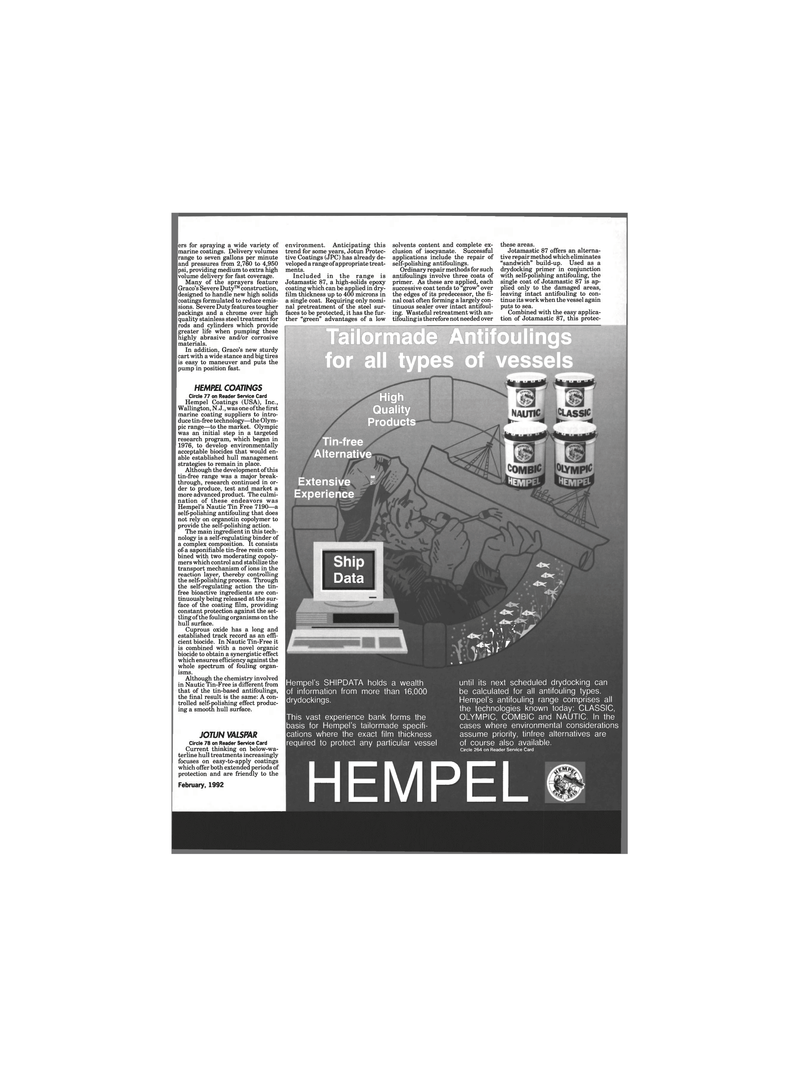
Page 33: of Maritime Reporter Magazine (February 1993)
Read this page in Pdf, Flash or Html5 edition of February 1993 Maritime Reporter Magazine
ers for spraying a wide variety of marine coatings. Delivery volumes range to seven gallons per minute and pressures from 2,760 to 4,950 psi, providing medium to extra high volume delivery for fast coverage.
Many of the sprayers feature
Graco's Severe Duty™ construction, designed to handle new high solids coatings formulated to reduce emis- sions. Severe Duty features tougher packings and a chrome over high quality stainless steel treatment for rods and cylinders which provide greater life when pumping these highly abrasive and/or corrosive materials.
In addition, Graco's new sturdy cart with a wide stance and big tires is easy to maneuver and puts the pump in position fast. environment. Anticipating this trend for some years, Jotun Protec- tive Coatings (JPC) has already de- veloped a range of appropriate treat- ments.
Included in the range is
Jotamastic 87, a high-solids epoxy coating which can be applied in dry- film thickness up to 400 microns in a single coat. Requiring only nomi- nal pretreatment of the steel sur- faces to be protected, it has the fur- ther "green" advantages of a low solvents content and complete ex- clusion of isocyanate. Successful applications include the repair of self-polishing antifoulings.
Ordinary repair methods for such antifoulings involve three coats of primer. As these are applied, each successive coat tends to "grow" over the edges of its predecessor, the fi- nal coat often forming a largely con- tinuous sealer over intact antifoul- ing. Wasteful retreatment with an- tifouling is therefore not needed over these areas.
Jotamastic 87 offers an alterna- tive repair method which eliminates "sandwich" build-up. Used as a drydocking primer in conjunction with self-polishing antifouling, the single coat of Jotamastic 87 is ap- plied only to the damaged areas, leaving intact antifouling to con- tinue its work when the vessel again puts to sea.
Combined with the easy applica- tion of Jotamastic 87, this protec-
HEMPEL COATINGS
Circle 77 on Reader Service Card
Hempel Coatings (USA), Inc.,
Wallington, N.J., was one of the first marine coating suppliers to intro- duce tin-free technology—the Olym- pic range—to the market. Olympic was an initial step in a targeted research program, which began in 1976, to develop environmentally acceptable biocides that would en- able established hull management strategies to remain in place.
Although the development of this tin-free range was a major break- through, research continued in or- der to produce, test and market a more advanced product. The culmi- nation of these endeavors was
Hempel's Nautic Tin Free 7190—a self-polishing antifouling that does not rely on organotin copolymer to provide the self-polishing action.
The main ingredient in this tech- nology is a self-regulating binder of a complex composition. It consists of a saponifiable tin-free resin com- bined with two moderating copoly- mers which control and stabilize the transport mechanism of ions in the reaction layer, thereby controlling the self-polishing process. Through the self-regulating action the tin- free bioactive ingredients are con- tinuously being released at the sur- face of the coating film, providing constant protection against the set- tling of the fouling organisms on the hull surface.
Cuprous oxide has a long and established track record as an effi- cient biocide. In Nautic Tin-Free it is combined with a novel organic biocide to obtain a synergistic effect which ensures efficiency against the whole spectrum of fouling organ- isms.
Although the chemistry involved in Nautic Tin-Free is different from that of the tin-based antifoulings, the final result is the same: A con- trolled self-polishing effect produc- ing a smooth hull surface.
JOTUN VALSPAR
Circle 78 on Reader Service Card
Current thinking on below-wa- terline hull treatments increasingly focuses on easy-to-apply coatings which offer both extended periods of protection and are friendly to the
February, 1992
Tailormade Antifoulings for all types of vessels
High
Quality
Products
Tin-free
Alternative
Extensive®®
Experience
Data *» yj ^ w
Hempel's SHIPDATA holds a wealth of information from more than 16,000 drydockings.
This vast experience bank forms the basis for Hempel's tailormade specifi- cations where the exact film thickness required to protect any particular vessel until its next scheduled drydocking can be calculated for all antifouling types.
Hempel's antifouling range comprises all the technologies known today: CLASSIC,
OLYMPIC, COMBIC and NAUTIC. In the cases where environmental considerations assume priority, tinfree alternatives are of course also available.
Circle 264 on Reader Service Card HEMPEL

 32
32

 34
34
